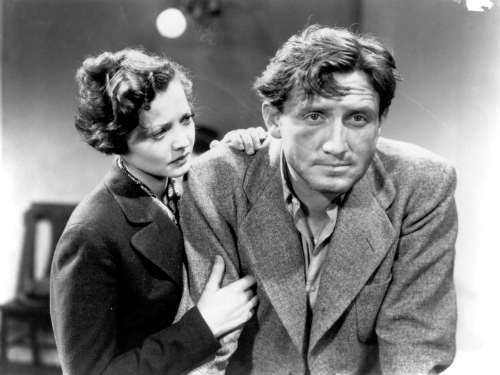
“The only film I know to which I have wanted to attach the epithet of ‘great’.”
Graham Greene
“A barbershop in a small Midwestern town. A patron, waiting to be shaved, holds forth about the need for a law that would ban radical ideas in schools. Another customer, the local teacher, reminds him: ‘It’s not possible to get a law that denies the right to say what one believes. In peace-time, anyway.’ The patron looks stunned and asks: ‘Who says so?’ The teacher replies: ‘The Constitution of the United States.’ ‘You should read it sometime,’ interrupts the elderly barber in heavily accented English. ‘You would be surprised. I had to read it to become an American. You never had to because you were born here.’
This telling exchange occurs in Fury, Fritz Lang’s first American film. [...] The scene suggests that foreigners know the basics of the US Constitution, while natives do not. Holding a straight razor, the immigrant barber hovers over the local customer who sits immobilized in the chair, foam across his face. The setting underscores the immigrant’s superior position with subtle comedy. Coming from outside the country but now living within it, immigrants and exiles have the privilege of being both insider and outsider – a position that allows them to examine their new surroundings with a critical eye. Fury’s barbershop scene epitomizes (in less than a minute of screen time) what many exile films have in common: a double-edged critique from a vantage point that compares and judges the new against the old, the unknown against the known, the present against the past, the indigenous against the foreign.
Sensitized from his own encounter with National Socialism, Lang felt empowered to point out what he considered fascist thinking in his newly adopted homeland. He also implies that banning free speech, as proposed in the barbershop scene, is part of a mentality that leads to mob violence and murder. Lang, whose last German film, The Testament of Dr. Mabuse, was banned by the Nazis in 1933, must have been suspicious of the internal censorship introduced by Will Hays in 1930, only a few years prior to his arrival in America. Lang’s plea for freedom of expression resonates more deeply when viewed in terms of his own experience in Nazi Germany; but the film’s response is equally critical of American citizens who do not live up to, and are even ignorant of, their own constitutional rights.”
Anton Kaes1
“Parallel scenes in Lang’s work show that the image, photo ID, and phantom reflection can work to elicit a sense of remorse so powerful that it turns into madness. The photographs of the little girls that Schränker offers to M trigger his verbal outburst; Dr. Baum again recounts what was already visible at the end of Spieler, how Mabuse goes mad watching as the phantoms of his victims appear; Matsumoto commits suicide after being hailed by the phantoms of the three messengers he sent to the grave; Fury’s lynchers break down at the sight of the film that proves their guilt. This, then, is the function of cinema: to transmit the image of the victim back to his executioner so as to drive him in turn mad with terror.”
Nicole Brenez2
- 1Anton Kaes, “A Stranger in the House. Fritz Lang’s Fury and the Cinema of Exile,” in A Companion to Fritz Lang, ed. Joe McElhaney, (Oxford: Wiley Blackwell, 2015), 300.
- 2Nicole Brenez, “Symptom, Exhibition, Fear Representations of Terror in the German Work of Fritz Lang,” in A Companion to Fritz Lang, ed. Joe McElhaney, (Oxford: Wiley Blackwell, 2015), 71.

